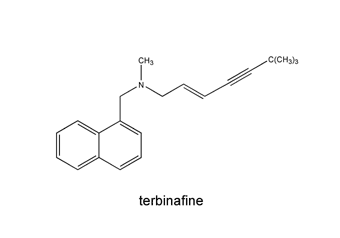Manufacturer’s Prescribing Information
Trade & Generic Names & General Features
Terbinafine is an allylamine structurally related to naftifine. It is a synthetic antifungal agent. It is highly lipophilic in nature and tends to accumulate in skin, nails, and fatty tissues [656, 1934].
Terbinafine has oral and topical (cream) formulations. Oral preparation has been first introduced in 1991 in United Kingdom and approved for clinical use in 1996 in USA [950, 1014]. It is being manufactured by Novartis Pharmaceuticals. Its trade name is Lamisil.

Mechanism(s) of Action
As with the other allylamines, terbinafine inhibits ergosterol biosynthesis via inhibition of squalene epoxidase. This enzyme is part of the fungal sterol synthesis pathway that creates the sterols needed for the fungal cell membrane.
Susceptibility Patterns
Terbinafine is mainly effective on a specific group of fungi, dermatophytes. However, a standard in vitro susceptibility testing methodology is not yet available for this group. Studies to address this to question are in progress. One of the parameters under investigation is the standard medium to be used in the test. This medium should enhance conidium formation in dermatophytes. Although as yet unstandardized, the in vitro activity of terbinafine has been tested against various dermatophytes. Terbinafine yields lower MICs compared to fluconazole, itraconazole, and griseofulvin [1121]. The meaning and clinical significance of these data demand further investigations and development of a standard in vitro susceptibility testing method.
Terbinafine has in vitro activity also against most Candida spp., Aspergillus spp., Sporothrix schenckii [1119], Penicillium marneffei [1489], Malassezia furfur [1767], Cryptococcus neoformans [1991], Trichosporon spp. and Blastoschizomyces [1990].
For terbinafine MICs obtained for various types of fungi, see susceptibility patterns and the N/A(L):susceptibility database.
Usual Doses
The typical dose of terbinafine is 250 mg/day [617].
Side-Effects
Adverse reactions to terbinafine are in general transient and mild. The incidence of these reactions has been found to be 10.5% in a large scale study. Most involve the gastrointestinal system and the skin [971]. Reversible agranulocytosis has been reported as a rare side effect [1694].
Routes
Terbinafine is available for oral and topical administrations. Topically, 1% cream and solution formulations are used.
Current Status
Terbinafine is one of the mainstays of treatment of dermatophytosis. Compared to the previously existing antifungal agent, griseofulvin, it is more effective, as well as being significantly less toxic. Moreover, the required duration of therapy is also shorter with terbinafine.
This property is of interest, particularly in cases of onychomycosis where prolonged courses of therapy are needed [114]. Terbinafine is a safe and efficacious agent in treatment of this clinical setting [617, 1014], as well as other dermatophytosis. It appears to be similarly or more effective than its alternative, itraconazole [522, 1934] and also fluconazole [1001].
Terbinafine, when combined with fluconazole, has occasionally been successful in treatment of oropharyngeal infections due to fluconazole-resistant Candida spp. [833]. An even more recent report suggests a possible role for terbinafine alone against azole-resistant oropharyngeal infections [2298].
